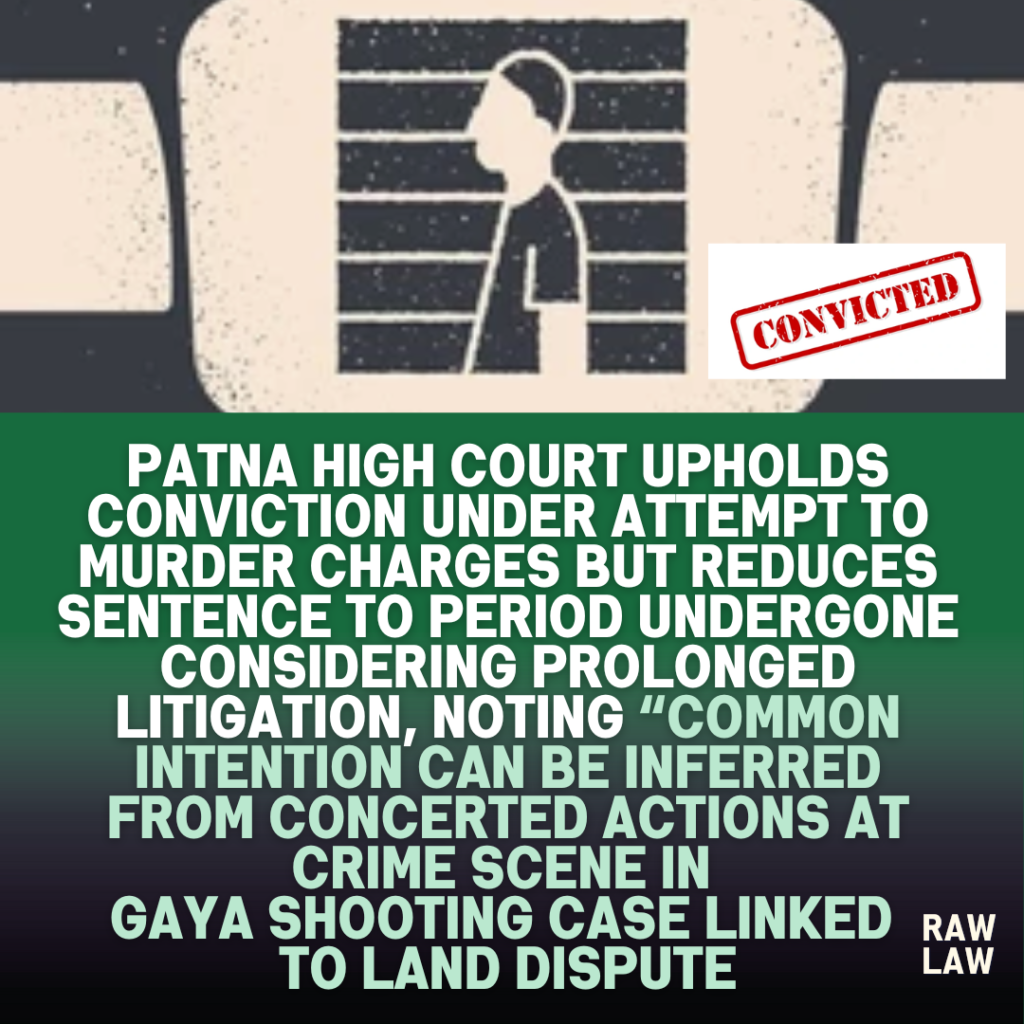Court’s Decision
The Patna High Court partly allowed the appeals by upholding the conviction under Section 307 read with Section 34 of the IPC and Section 27 of the Arms Act while reducing the sentence to the period already undergone by the appellants, considering their prolonged incarceration and the 19-year pendency of the matter since the 2006 incident. The court directed that the appellants stand discharged from bail bond liabilities, while affirming that the charges were proved beyond reasonable doubt.
Facts
The case arose from a 2006 incident in Gaya where the informant, while returning home, was stopped near Delha Bus Stand by the appellants, with allegations that Guddu Yadav fired at the informant causing injury to his right shoulder while another bullet hit a passerby, Mukesh Kumar, in his thigh. It was alleged that the appellants also robbed the informant of cash and a gold chain. The incident was linked to an ongoing land dispute between the parties, and the police registered the case under Sections 307, 326, 379, 504, and Section 27 of the Arms Act.
Issues
- Whether the prosecution proved the charges of attempt to murder under Section 307 read with Section 34 IPC and Section 27 Arms Act beyond reasonable doubt.
- Whether the alleged inconsistencies in witness testimonies regarding the place of occurrence and delay in FIR recording undermined the prosecution case.
- Whether the prolonged litigation and period already undergone by the appellants warranted a reduction in sentence.
Petitioner’s Arguments
The appellants argued that:
- There were contradictions regarding the exact place of occurrence.
- Delay in FIR recording without explanation cast doubts on the prosecution case.
- The injured independent witness (PW-13) did not identify the appellants at the crime scene.
- The witnesses were interested parties with prior criminal antecedents, undermining their credibility.
- There was an ongoing land dispute, and the incident was used to falsely implicate the appellants.
- Given the prolonged litigation, the sentence should be reduced to the period already undergone.
Respondent’s Arguments
The State argued that:
- The prosecution established guilt beyond reasonable doubt through consistent witness testimonies and corroborating medical and documentary evidence.
- The presence of the appellants at the crime scene, premeditation, and firing on the informant supported the conviction under Section 307 read with Section 34 IPC.
- The delay in FIR recording was explained, and the contradictions in place of occurrence were minor and did not affect the core prosecution case.
- Reduction of sentence was opposed considering the seriousness of the offence.
Analysis of the Law
The Court analysed:
- The essentials under Section 307 IPC require intention or knowledge to cause death coupled with an overt act, while Section 34 requires proof of common intention and participation.
- Section 27 of the Arms Act applied as the firearm was used in the commission of the offence.
- Applying Ezajhussain Sabdarhussain v. State of Gujarat and Ramashish Yadav, the Court held that common intention can be inferred from the premeditation and actions of the accused at the scene.
- The prosecution’s evidence, supported by the injury report, established the occurrence of the incident and the participation of the appellants.
Precedent Analysis
The Court referred to:
- Ezajhussain Sabdarhussain v. State of Gujarat (2019) 14 SCC 339: Explained principles of joint liability under Section 34.
- Ramashish Yadav v. State of Bihar: Affirmed that prearranged plans can be inferred from conduct and circumstances.
- Distinguished Munna @ Satish v. State of U.P. (2023) 1 SCC 714, noting that in the present case, the place of occurrence was consistent across witnesses and corroborated by the investigating officer.
Court’s Reasoning
The Court found that:
- The presence of the appellants at the scene, demand for extortion, subsequent firing, and immediate robbery established the existence of common intention.
- Minor contradictions regarding the place of occurrence did not weaken the prosecution case.
- The evidence of the medical officer and injury reports corroborated the injuries sustained by the victims.
- Given the long pendency of the matter, the suffering undergone by the appellants during trial, and their custody period, it was appropriate to reduce the sentence to the period already undergone.
Conclusion
The Patna High Court:
- Affirmed the conviction under Sections 307/34 IPC and Section 27 Arms Act.
- Reduced the sentence to the period already undergone by the appellants.
- Ordered the appellants to be discharged from bail bond liabilities.
Implications
- Reinforces that common intention in violent crimes can be inferred from collective actions at the crime scene.
- Clarifies that minor inconsistencies on location do not vitiate a case if the core evidence is intact.
- Balances retributive justice with the need to consider prolonged litigation and the period already undergone by convicts in appropriate cases.
Referred Cases and Their Relevance
- Ezajhussain Sabdarhussain v. State of Gujarat: Clarified joint liability and common intention principles under Section 34.
- Ramashish Yadav v. State of Bihar: Explained how prearranged plans can be inferred.
- Munna @ Satish v. State of U.P.: Distinguished due to different factual matrix.
FAQs
Q1: Can common intention under Section 34 IPC be inferred from conduct?
Yes, it can be inferred from the collective actions and premeditation evident at the crime scene.
Q2: Is minor inconsistency about the place of occurrence fatal to the prosecution’s case?
No, if the core facts and evidence align, minor inconsistencies do not undermine the case.
Q3: Can sentence be reduced to the period undergone in long-pending cases?
Yes, courts may consider reducing the sentence to the period already undergone in cases involving prolonged litigation and custodial suffering.
